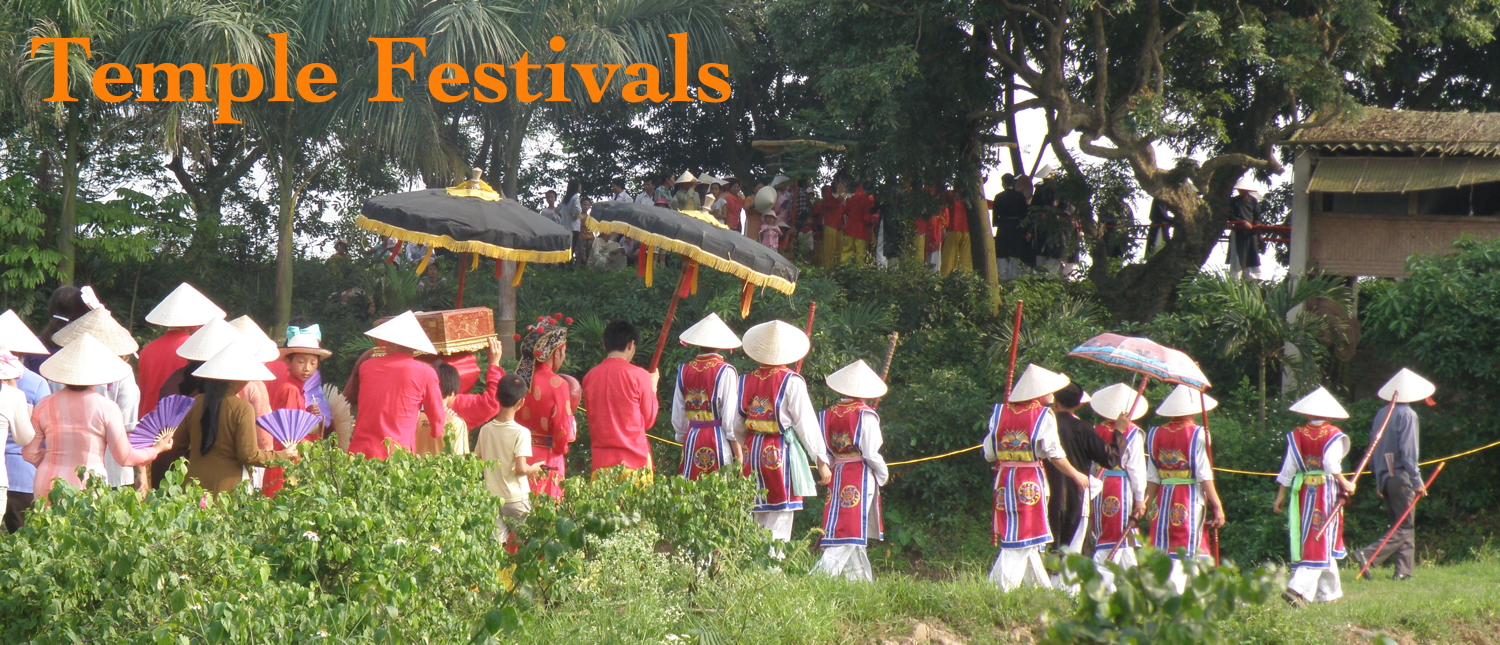Lễ Hội: Temple “Festivals” in Vietnam
One of the best ways to explore a temple in Vietnam is to go on one of its festival days. The word “festival,” as commonly used in translation, does not quite cover these events. The Sino-Vietnamese term is “Lễ Hội” which is a combination of “Rituals” with “Gathering”—suggesting both a sacred ceremony, carried out by literati officials, and a public celebration.
The ritual performance (lễ, Chinese (li 禮), “sacrificing to the spirits,” was the part that Confucius regarded as essential for the maintenance of civilized society and to regulate one’s own character.
2.3 The Master said, “If you try to guide the common people with coercive regulations (zheng 政) and keep them in line with punishments, the common people will become evasive and will have no sense of shame. If, however, you guide them with Virtue, and keep them in line by means of ritual, the people will have a sense of shame and will rectify themselves.”
3.12 “Sacrifice as if [they were] present” means that, when sacrificing to the spirits, you should comport yourself as if the spirits were present.
The Master said, “If I am not fully present at the sacrifice, it is as if I did not sacrifice at all.”
6.27 The Master said, “Someone who is broadly learned with regard to culture, and whose conduct is restrained by the rites, can be counted upon to not go astray.”
Confucius, Analects, Edward Slingerland translation.
Many of the customs of the lễ hội were developed in China, where the analogous term is miaohui (庙会), meaning “temple gathering,” but often translated as “temple fair.” These ceremonies and celebrations are observed in Chinese communities throughout Southeast Asia (Malaysia, Manila, Singapore).
With the revival of interest in traditional culture, many temples now sponsor complex ceremonies performed by men (and sometimes women) in formal but colorful robes. These can include preliminary ceremonies to “invite” the spirit to attend their anniversary, the opening of wooden cases to examine the sắc phong (certificates granted by the imperial court, if the temple has such documents), and so forth. At the same time, the occasion is an opportunity for general entertainment, like a medieval fair or the Bastille Day or Fourth of July events in small towns in France and America.
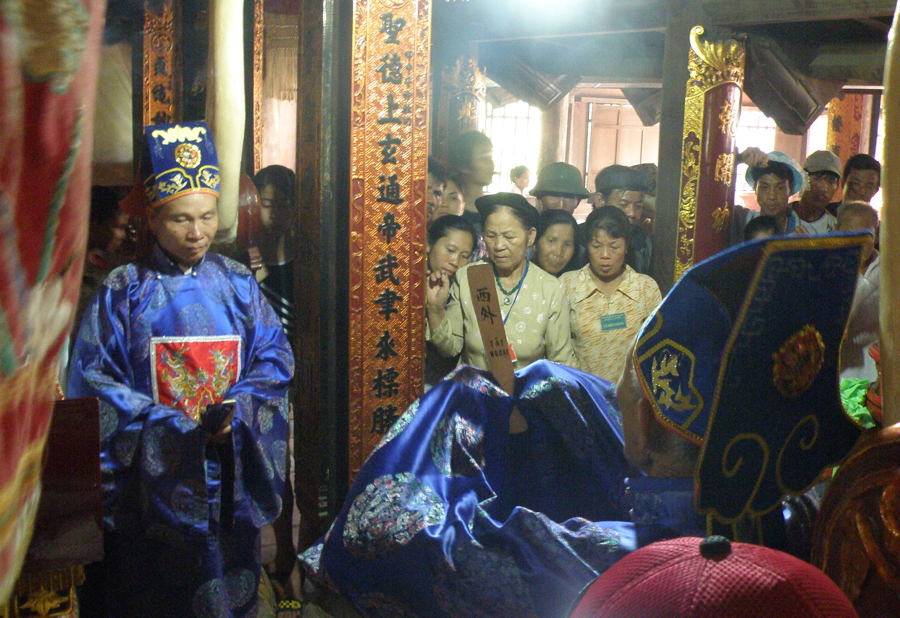
Above: Robed officiants perform the rites to the spirit-hero Thánh Gióng at the Đền Phù ĐổngBelow: Inspection of the royal scrolls (sắc phong) at the Đình Thắng Tam in Vũng Tàu.
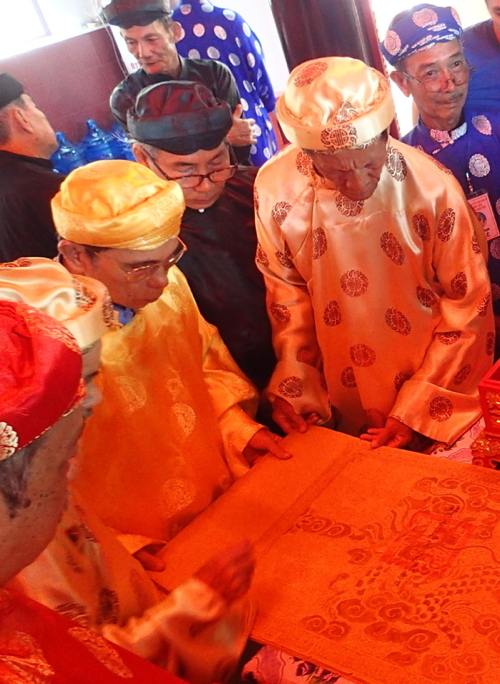
The festival gatherings generally last three to five days, and are held on the death anniversary of a spirit worshipped at the temple. The dates given for these festivals are always set by the lunar calendar (âm lịch), so, although they are quite regular, they shift from year to year on our western calendar. For instance, the festival at the “Mulberry Pagoda” (Chùa Dâu) near Hanoi is held on “ngày 8/4 âm lịch,” which means the eighth day of the fourth lunar month.
It’s worth taking a look at Chùa Dâu’s festival, as this pagoda represents the earliest center of Buddhism in Vietnam, when Luy Lâu (in today’s Bắc Ninh) was the provincial capital of Giao Chỉ (as the Red River area was called under the Han Dynasty. Though it is a Buddhist pagoda, its history is intertwined with local legend and an older tradition that worshipped the four goddesses of clouds, rain, thunder, and lightning. The prefix “Pháp,” meaning “Dharma,” was added to their names, so they are called Pháp Vân, Pháp Vũ, Pháp Lôi, Pháp Điện.
There are several other temples around Chùa Dâu that worship the other goddesses, and it is the custom to have a palanquin procession from one to another to gather their statues or spirit-tablets, with ceremonies at each temple to invite the “sister” spirits to attend. Such relationships between temples are even more common among the village community houses (đình) and other temples to regional spirits (đền).
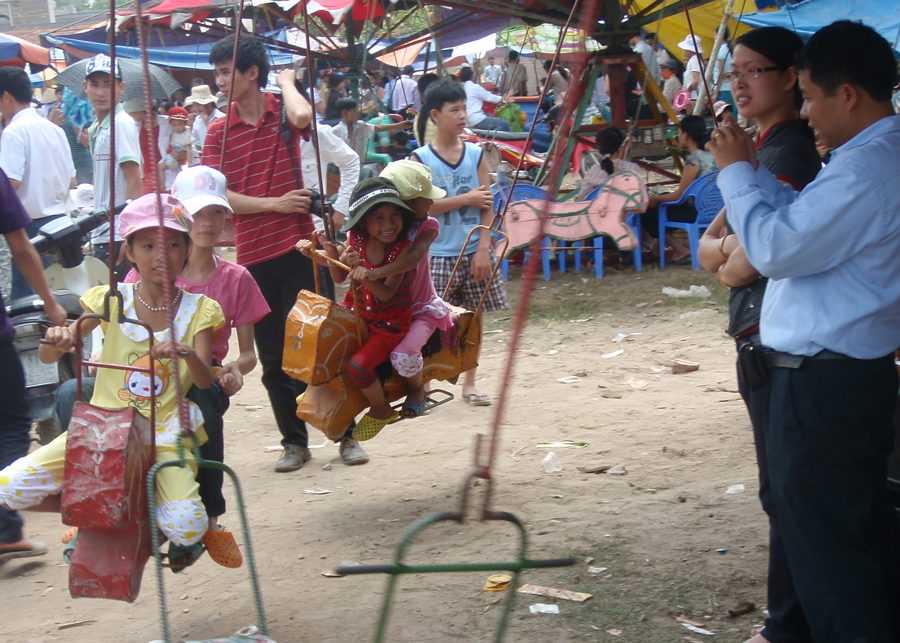
The festival atmosphere includes whirligigs for children (Chùa Dâu) and the sales of toys, souvenirs, and votive offerings (Kiếp Bạc)
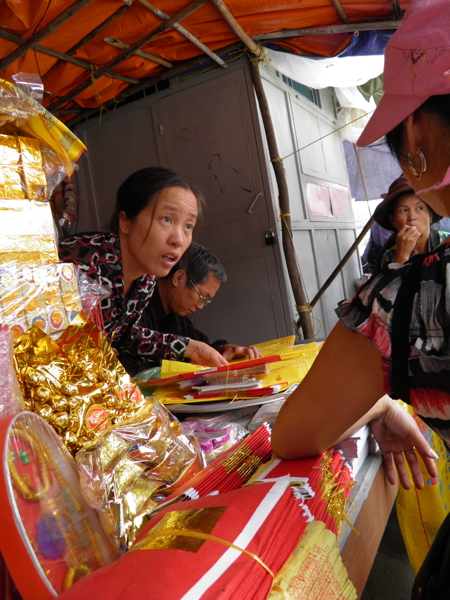
People come from nearby or even faraway provinces to attend the most famous festivals. One of the most popular is in Châu Đốc, on the Mekong at the border with Cambodia. Philip Taylor has written extensively about this celebration of Bà Chúa Xữ (Lady of the Realm) in his seminal study, Goddess on the Rise.
Bà Chúa Xứ shrines are scattered throughout the Mekong delta, but the place to be on her anniversary days (22-27 of the fourth lunar month) is in her “home” temple in Châu Đốc. As Taylor relates, many shopkeepers and businesswomen in Saigon will charter a van or other transportation to go to Châu Đốc to pay their respects to the goddess—one of the purposes being to “repay” the goddess for their good fortune in business. That is, they symbolically “borrow” money from the goddess, and then repay her with a roast pig or other offering.
Like the goddess Ba Chua Kho, whose shrine is just north of Hanoi, the Chau Doc goddess has come to be seen as a spirit of financial increase … people "borrow" money from her, which is imbued with the power to magically augment one's own financial reserves.
… Although one requests (xin) this money from the goddess it consists of the money already presented to her either by oneself or by earlier supplicants. After lying on. the altar for a while the bills become infused with her powers of reproduction and growth. These bills are kept and never spent, for they are thought capable of reproducing more money and making one's capital grow.
… The practice of transacting with the goddess is particularly entrenched among those who are involved in providing commercial credit. It is these people who make the offerings of pigs, gold, and costumes to her and who propitiate her most faithfully.
-- Goddess on the Rise, Philip Taylor, pages 89-90.
Different regions have different guardian spirits. In the mountains of Lào Cai, the region is protected by the spirit of a Vietnamese commander who died while fighting northern invaders. His cult has been integrated into the Thánh Mẫu (Holy Mothers) tradition, where he is identified as the Seventh Prince (Hoảng Bảy). Temples to the Thánh Mẫu can be found at sacred sites throughout the northern provinces.
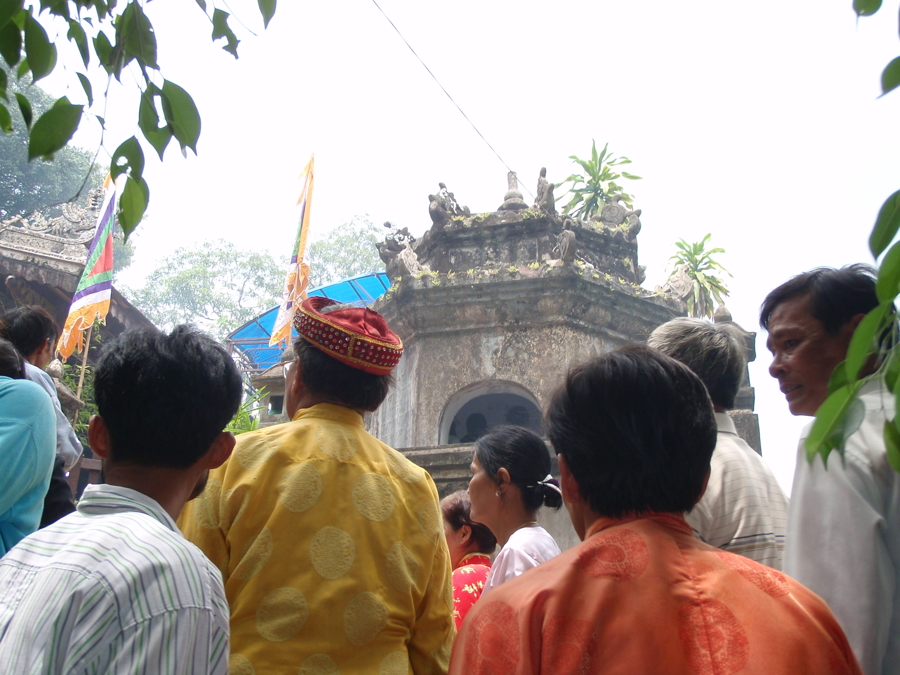
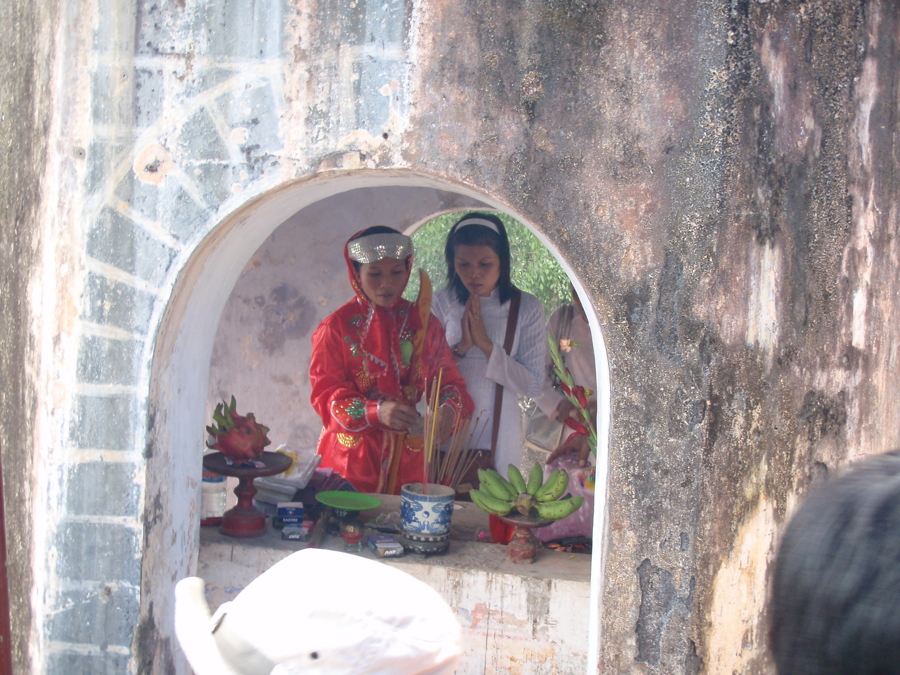
A restless crowd awaits entry to the Điện Hòn Chén temple in Huế, August 2009. Some visitors bring a medium to help them perform rituals to the spirits.
Temples along the coast hold ceremonies for the whale-spirit, known as Ông Nam Hài (Lord of the South Sea), and for the “four divine spirit-ladies” (Tứ vị Thánh Nương), the four royal ladies of the Song court who leapt into the sea off the island of Hainan to avoid capture by Kublai Khan’s armada in 1279.
In our twenty years of travels from the north to the south, we have seen a dizzying variety of these anniversary celebrations:
- at the Bắc Lệ temple, near the border with China, performances of songs in the Thánh Mẫu tradition, honoring the Mother of Mountains and Forests.
- east of the ancient capital of Thăng Long (now Hanoi), a procession and ceremonies to the spirit of “Thánh Gióng,” the legendary hero who grew to giant size and defeated foreign invaders.
- in the same area, the festival at Chùa Dâu, to honor the Dharma Goddess of Clouds (Pháư Vân).
- at Kiếp Bắc, near the site of the great victory against the Yuan invaders (Battle of Bạch Đằng River, 1288), the anniversary ceremonies for the great commander Prince Trần Hưng Đạo.
- in Thanh Hóa city, where brightly robed officiants performed the ancient rituals at the temple to the emperors of the Lê Dynasty.
- in the city of Vinh, Nghệ An province, at the temple of the Tenth Prince (Hoàng Mười).
- at Điện Hòn Chén, on the Perfume River in Huế, in honor of the “Vietnamized” goddess Thiên Y A Na.
- at the Po Klaung Gerai and Po Ro Me temples in Phan Rang, on the occasion of the autumn Katé festival of the Cham people.
- in Vũng Tàu, where ceremonies were held over three days to honor the Tứ vị Thánh Nương at Đình Thắng Tam.
- in rural communities near Trà Ôn (Vĩnh Long province), where Khmer villagers went to the wat to celebrate Ok Om Bok with the monastic communities.
- in Cầu Kè (Trà Vinh province), at the temples to Ông Bồn, the ubiquitous deity of the Ming diaspora in Southeast Asia.
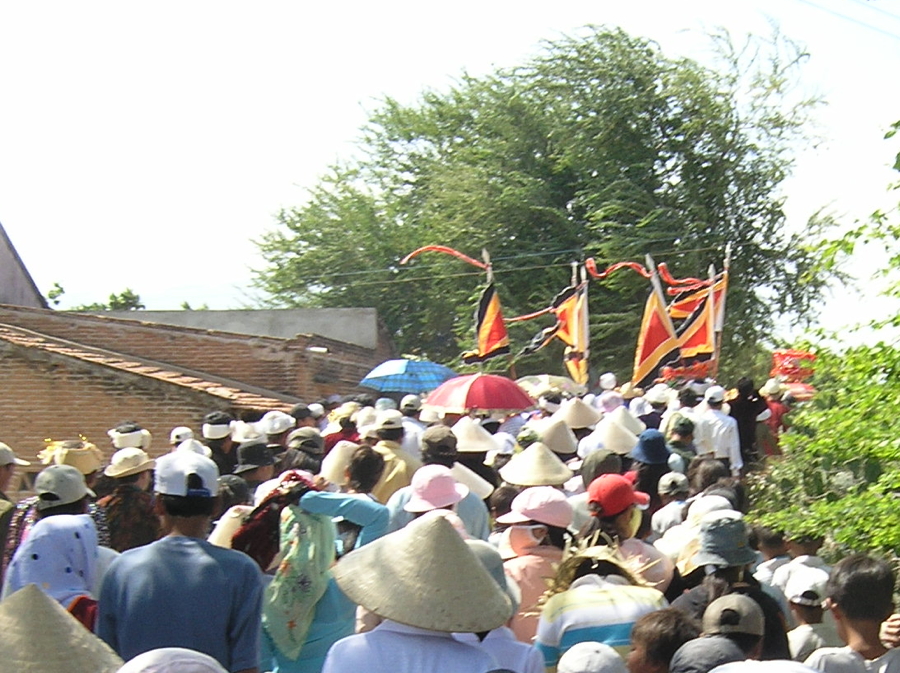
A crowd follows the procession to the outskirts of the Cham village of Hữu Đức, where they will receive the robes and ceremonial objects kept for them by the Raglai highlanders (October 2006). See the page on Phan Rang for more information. [link to: http://lesserscribe.net/Daiviet/Panduranga.html]
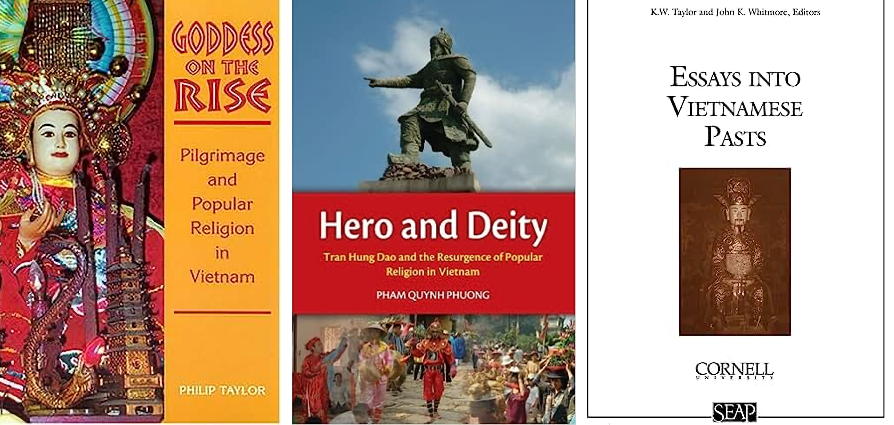
- “Popular Buddhism in the Region of Dâu,” Phan Đại Doãn, Vietnamese Studies, 1996 (1).
- Goddess on the Rise: Pilgrimage and Popular Religion in Vietnam, Philip Taylor, University of Hawaii Press, 2004.
- Hero and Deity: Tran Hung Dao and the Resurgence of Popular Religion in Vietnam, Pham Quynh Phuong, Silkworm Books, 2009.
- Essays into Vietnamese Pasts, edited by K. W. Taylor and John K. Whitmore, Cornell, Southeast Asia Program Publications, 1995. See “The Legend of Ông Dóng from the Text to the Field,” Trần Quốc Vửợng; “The Vietnamization of the Cham Deity Pô Nagar,” Nguyễn Thế Anh.
- Modernity and Re-Enchantment: Religion in Post-Revolutionary Vietnam, Philip Taylor, Institute of Southeast Asian Studies, Singapore, 2007.
- Performing the Divine: Mediums, Markets and Modernity in Urban Vietnam, Dr. Kirsten W. Endres, NIAS Press, 2011.
- Cult, Culture, and Authority: Princess Lieu Hanh in Vietnamese History, Olga Dror, University of Hawaii Press, 2007.
